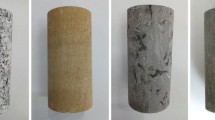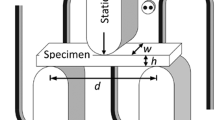Abstract
A Georgia kaolinite, at water contents from 55 to 95 per cent, was tested by means of a Weissenberg Rheogoniometer under conditions of pure shear with sinusoidally varying deformation over a frequency range of 3 decades. The results, including time-dependent effects, are expressed in terms of the magnitude of the complex modulus and the phase angle, as developed in the theory of linear viscoelasticity, and stress-strain hysteresis curves. The complex modulus is a two-component quantity, which has a real part associated with the elastic or energy storage characteristics of the material and an imaginary part associated with its viscous or energy dissipation characteristics. Although the complex modulus interpretation is very good for linearly viscoelastic materials, its applicability and usefulness diminishes as the material departs from linear viscoelastic behavior. On the other hand, the determination of energy dissipation from stress-strain hysteresis curves does not depend on any assumption concerning material behavior, because the area enclosed by the curve gives a direct measure of the energy dissipated in a single cycle of deformation. The dissipation characteristics obtained by the two methods are compared and used to illustrate the degree of validity and some limitations of linear viscoelasticity theory.
Résumé
On a fait des expériences sur une kaolinite géorgienne, à teneur d’eau de 55 à 95% à l’aide d’un Rhéogoniomètre Weissenberg sous des conditions de cisaille pure avec déformation de variation sinusoïdale dur une gamme de fréquence de trois décennies. Les résultats, y-compris les effets tributaires du temps, sont exprimés par rapport à la taille du module complexe et de l’angle de phase, tels qu’ils sont développés dans la théorie de la viscoélasticité linéaire, et les courbes d’hystérésis par suite des diverses tensions. Le module complexe est une quantité à deux composantes, dont la partie réelle s’associe aux caractéristiques d’élasticité ou de conservation d’énergie de la matière, alors que la partie imaginaire s’associe aux caractéristiques de viscosité ou de dissipation d’énergie. Bien que l’interprétation du module complexe soit excellente pour les matières à viscoélasticité linéaire, elle devient de moins en moins applicable et utile à mesure que la matière s’ loigne d’un comportement viscoélastique linéaire. Cependant la détermination de la dissipation d’énergie par des courbes d’hystérésis par suite des diverses tensions ne dépend pas, elle, d’hypothèses quant au comportement de la matière, puisque la surface englobée par la courbe donne une mesure directe de l’énergie dissipée au cours d’un cycle unique de déformation. Les caractéristiques de dissipation obtenues grâce aux deux méthodes sont comparées et servent à illustrer le degré de validité et certaines des limitations de la théorie de la viscoélasticité linéaire.
Kurzreferat
Ein Georgia Kaolinit wurde bei Wassergehalten von 55 bis 95 Prozent, mit Hilfe eines Weissenberg Rheogoniometers unter reinen Schubbedingungen mit sinusförmig verlaufender Deformierung über einen Frequenzbereich von 3 Dekaden geprüft. Die Ergebnisse, einschliesslich der zeitgebundenen Effekte, werden in Form der Grösse des Komplexmoduls und des Phasenwinkels, gemäss der Theorie der linearen Visko-Elastizität, und von Spannungs-Dehnungs Hysterese Diagrammen ausgedrückt. Der Komplexmodul setzt sich zusammen aus einem wirklichen Bestandteil, der sich auf die elastischen oder energiespeichernden Eigenschaften des Materials bezieht, und einem imaginären Bestandteil, der mit den Zähigkeits und Energiedissipationsmerkmalen desselben verknüpft ist. Obwohl sich linear visko-elastisches Material ausgezeichnet zur Erfassung durch den Komplexmodul eignet, verringert sich dessen Anwendbarkeit bei Abweichung des Materials vom linear visko-elastischen Verhalten. Andrerseits ist die Bestimmung der Energiedissipation aus Spannungs-Dehnungs-Hysterese-Diagrammen unabhängig von Annahmen bezüglich des Materialverhaltens, da das durch die Kurve eingeschlossene Feld ein direktes Mass für die in einem einzelnen Deformierungszyklus dissipierte Energie liefert. Die nach beiden Methoden erhaltenen Dissipation-smerkmale werden verglichen und dazu verwendet das Mass der Gültigkeit und gewisse Grenzen der Theorie der linearen Visko-Elastizität aufzuzeigen.
Резюме
Джорджиа-каолинит, с водосодержанием от 55 до 95%, был исследован пользуясь реогониометром Вейссенберга в условиях чистого среза с синусоидально меняющейся деформацией в частотном диапазоне 3 декад. Результаты, включая зависящие от времени эффекты, выражаются как величина комплексного модуля и фазового угла по теории линейной вязкоупругости и как кривые гистеризсные зависимости деформации от напряжения. Комплексный модуль это двухкомпонентная величина, которая имеет настоящую часть, связанную с характеристиками упругости или хранения энергии материала, и мнимую часть, связанную с характеристиками вязкости и рассеяния энергии. Хотя толкование комплексного модуля и есть очень хорошим для линейно вязкоупругих материалов, применяемость и пригодность его понижается по мере того, как материал отходит от своего линейного вязкоупругого поведения. С другой стороны, определение рассеяния энергии на основании гистеризных петель зависимости деформаций от напряжения не является результатом какого-либо предположения о поведении материала, так как площадь ограниченная кривой дает непосредственный отсчет энергии, рассеянной в одном цикле деформации. Характеристики рассеяние, установленные этимидва методами, сравни аются и применяются для того, чтобы иллюстрировать степень пригодности и некоторые ограничения теории линейной вязкоупругости.
Similar content being viewed by others
References
Bland, D. R. (1960) The Theory of Linear Viscoelasticity: Pergamon Press, London.
Ferry, J. D. (1961) Viscoelastic Properties of Polymers: Wiley, New York.
Gross, B. (1953) Mathematical Structure of the Theories of Viscoelasticity: Hermann, Paris.
Hampton, D., and Wetzel, R. A. (1966) Stress Wave Propagation in Confined Soils: Tech. Report AFWL-TR-66-56, Air Force Weapons Lab., Kirtland Air Force Base, New Mexico.
Kolsky, H. (1963) Stress Waves in Solids: Dover Publications, New York.
Kondner, R. L., and Ho, M. M. K. (1965) Energy dissipation of a cohesive soil by the Fourier transformation of stress relaxation response; Trans Soc. Rheol. 9, 145–157.
Krizek, R. J. (1964) Application of the one-sided Fourier transform to determine soil storage and dissipation characteristics: Proc. Symp. Soil-Structure Interaction, Tucson, Arizona, 625–633.
Krizek, R. J., and Franklin, A. G. (1966) Viscoelastic shear response of a kaolinite: Clays and Clay Minerals 15, 227–240.
Parmelee, R. A., Penzien, J., Scheffey, C. F., Seed, H. B., and Thiers, G. R. (1964) Seismic Effects on Structures Supported on Piles Extending Through Deep Sensitive Clays: Report Univ. California, Berkeley to Calif. State Div. Highways, Calif.
Rao, N. S. G., and Nagaraj, T. S. (1967) Influence of initial soil structure on shear strength characteristics of saturated kaolinite clay subjected to vibratory loading: Proc. Southeast Asian Regional Conf. Soil Engr., Bangkok, 67–74.
Seaman, L., and Whitman, R. V. (1964) Stress Propagation in Soils: Final Report, Part IV, by Stanford Research Inst. Defence Atomic Support Agency, DASA 1266-4.
Seaman, L. (1966) One-Dimensional Stress Wave Propagation in Soils: Final Report by Stanford Research Inst. Defense Atomic Support Agency, DASA 1757.
Author information
Authors and Affiliations
Rights and permissions
About this article
Cite this article
Franklin, A.G., Krizek, R.J. Energy Dissipation of a Kaolinite at Different Water Contents. Clays Clay Miner. 16, 353–364 (1968). https://doi.org/10.1346/CCMN.1968.0160504
Received:
Published:
Issue Date:
DOI: https://doi.org/10.1346/CCMN.1968.0160504




